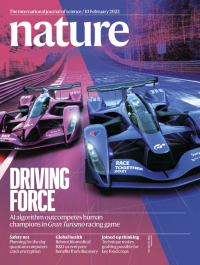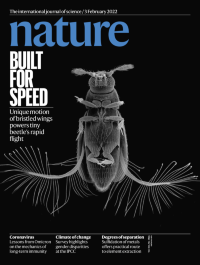Volume 602
-
No. 7898 24 February 2022
Omicron & antibodiesThe cover shows human bronchial cells infected with SARS-CoV-2, captured using a scanning electron microscope. In this week’s issue, a collection of six papers reveals key information about the ability of the highly infectious Omicron variant to evade existing vaccines. Since it was identified last November, Omicron has spread around the globe at a remarkable rate. Together, the papers in this issue show that Omicron’s high level of mutations allows it to dodge many elements of the immune response raised against it. Crucially, however, vaccines do retain some efficacy, albeit at a reduced level, while booster shots greatly enhance protection against infection and serious illness.
-
No. 7897 17 February 2022
Seeing redEinstein’s general theory of relativity predicts that Earth’s gravity will sufficiently distort space-time so that clocks at different distances from the planet will tick at different rates — an effect called gravitational redshift. In this week’s issue, Tobias Bothwell, Jun Ye and their colleagues demonstrate this effect at a sub-millimetre scale. The researchers use a cloud of ultracold strontium atoms, effectively creating a series of atomic clocks. As illustrated on the cover, the atoms are trapped in pancake-like optical traps and then interrogated by a laser. The team was able to observe a linear change in frequency — the redshift — from one side of the cloud to the other, showing that each atomic clock was ticking at a slightly different rate.
-
No. 7896 10 February 2022
Driving forceMany potential applications for artificial intelligence require making real-time decisions. Car racing, in which drivers must undertake complex tactical manoeuvres while controlling their vehicle at its performance limits, represents just such a challenge. In this week’s issue, Peter Wurman and his colleagues present an AI agent called Gran Turismo Sophy (GT Sophy) that can outcompete world champion-level human players in the PlayStation 4 racing game Gran Turismo Sport. The researchers used deep reinforcement learning to teach GT Sophy how to race. GT Sophy subsequently won head-to-head competitions against four of the world’s best Gran Turismo Sport drivers, racing over three car and track combinations. The team suggests the results could improve simulations used to train drivers and could also have applications in systems such as aerial drones and self-driving vehicles.
-
No. 7895 3 February 2022
Built for speedThe cover shows the feather-like wings of the tiny beetle Paratuposa placentis. How fast an animal can fly is usually dictated by its size: the larger the animal, the faster it flies. But at just 395 micrometres big, P. placentis bucks this trend by flying as fast as insects three times its size. In this week’s issue, Alexey Polilov and his colleagues reveal how it achieves such a feat. The researchers generated 3D reconstructions of the structure and motion of the beetle’s wings. They found that the insect moves its light, bristled wings in a very broad figure-of-eight loop and that the overall amplitude of its wing strokes is increased. The team suggests that the adaptations could help to explain the evolutionary success of extremely small insects.




